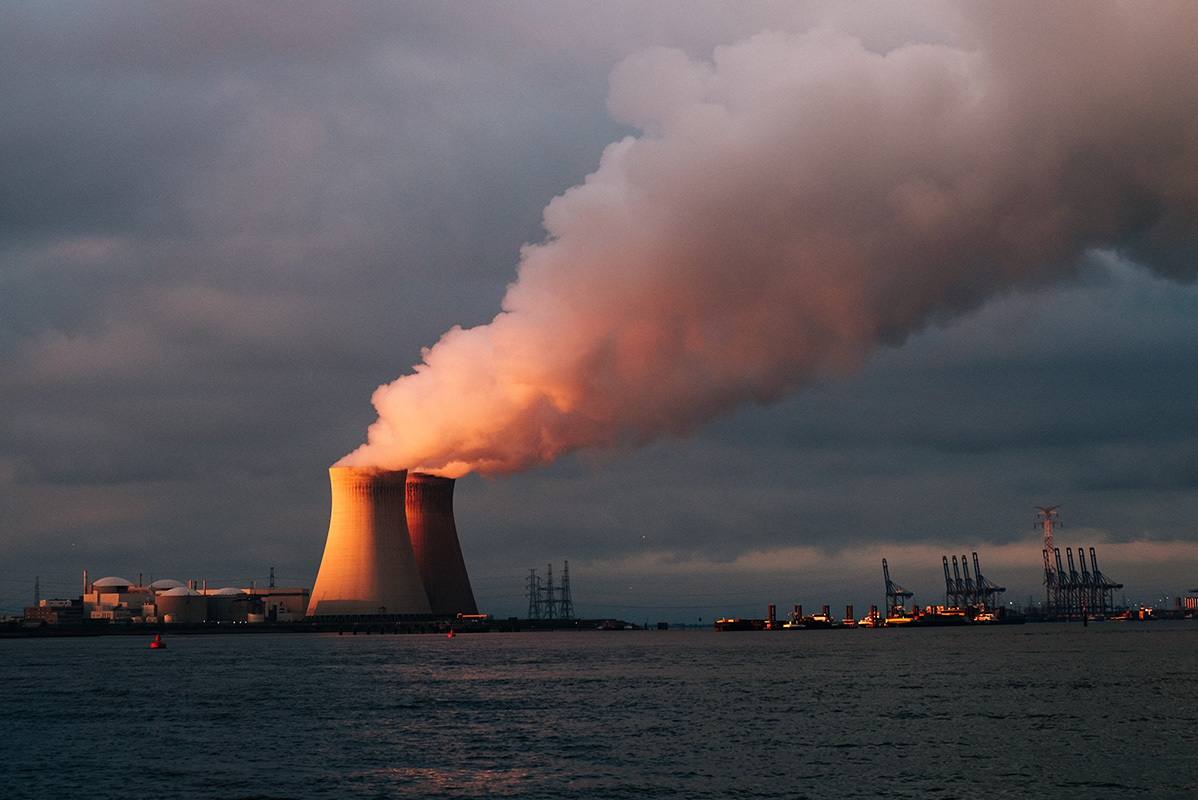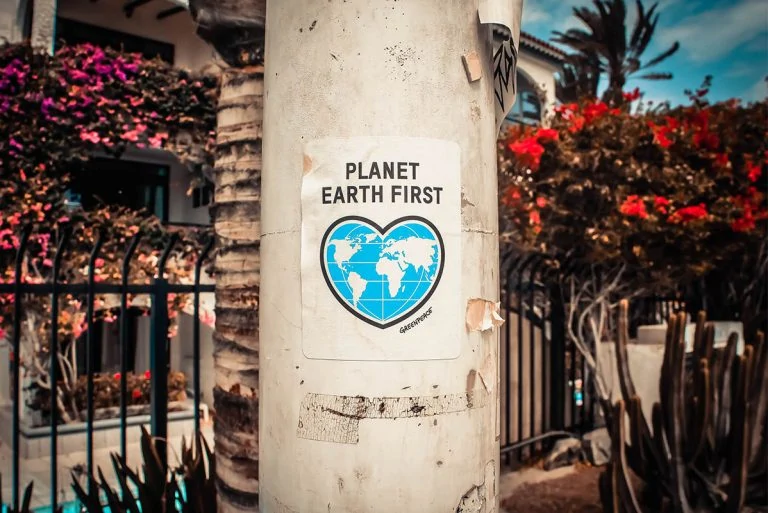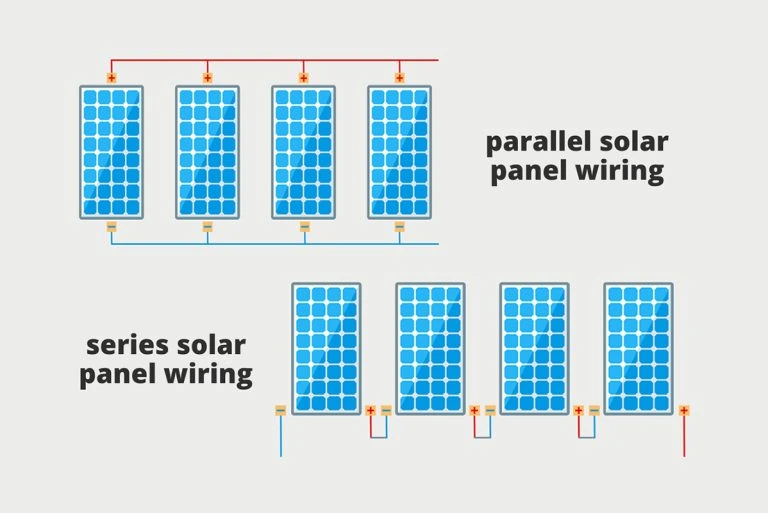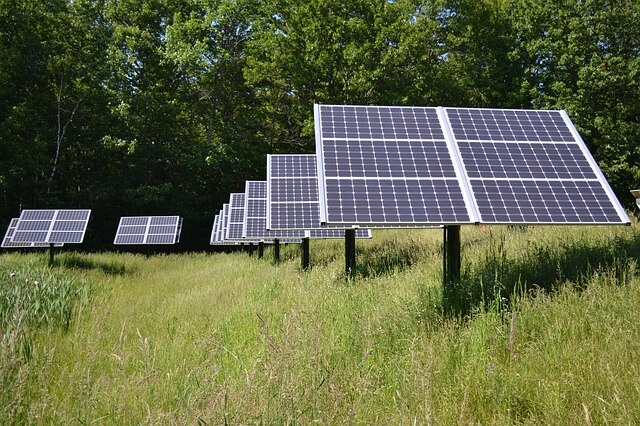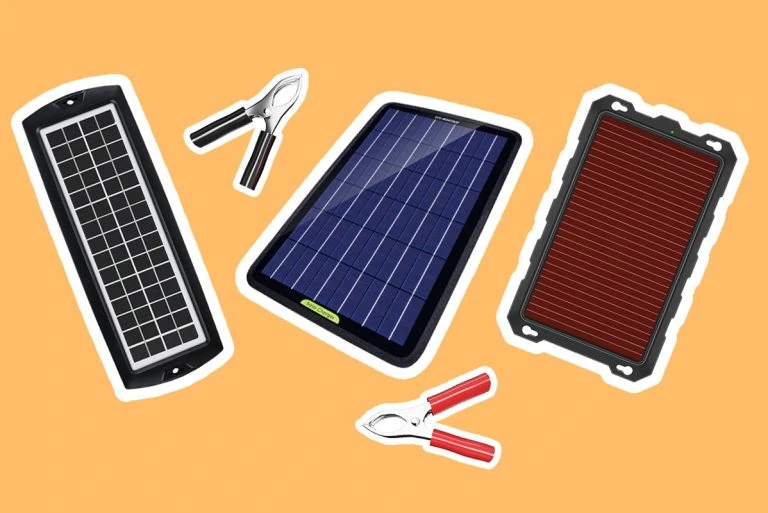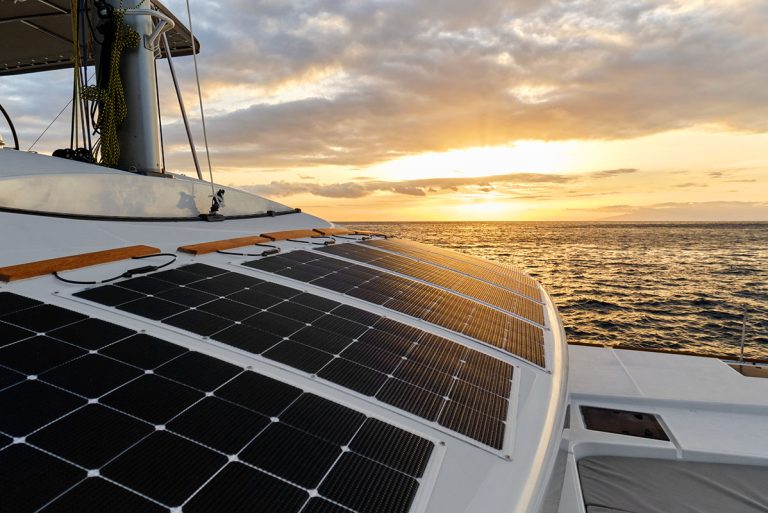As demand for energy increases at the same time as we’re depleting our fossil fuel reserves, society is looking for reliable, efficient, and renewable alternatives. Nuclear energy may be the answer, ticking all these boxes and more, (and many countries have been using it as a source of energy for some time) but it also has its drawbacks.
What is nuclear energy?
Before we discuss the pros and cons of nuclear energy, it’s important to get clear on what it is we are actually talking about – with a clear definition and explanation.
All matter on earth is made up of tiny particles called atoms, composed of even small particles called protons, neutrons, and electrons.
The positively-charged protons and neutral neutrons make up the center, or nucleus of the atom, with the negatively-charged electrons forming a cloud around it. The bonds between the protons and neutrons help to hold the nucleus together.
These bonds contain massive amounts of energy which is released if they break down. This process, of breaking apart the nucleus of an atom by destroying these bonds is known as fission, nuclear fission.

This is where nuclear energy comes from, so named because the energy is produced by breaking down the nucleus of an atom.
In this process, the energy released through the fission reaction serves as a source of heat. In a nuclear power plant, the heat is usually used to turn water into steam which turns turbines, producing electricity.
The most common fuel used in nuclear power plants today is uranium, or U-235. In the nuclear fission reaction, a collides with a uranium atom, splitting it.
Along with releasing energy in the form of heat, when the uranium atom splits, it also releases a neutron from its nucleus, which collides with another uranium atom nearby. This repeats over and over in a self-sustaining chain reaction.
Currently, 28 US states have at least one commercial nuclear reactor, with a total of 93 operating reactors at 55 facilities across the country. Combined, these reactors can generate up to 95,492 MW of electricity – to put this in context, 1 megawatt can power the average US home for 1.2 months.
Advantages and disadvantages of nuclear energy
Nuclear energy has incredible potential to replace fossil fuels in order to power our homes, businesses, and industry, without the greenhouse gas emissions and much of the pollution associated with coal, oil, and gas.
However, there are some serious concerns associated with nuclear power, so it’s important to understand both the benefits and drawbacks of this type of energy.
Benefits of nuclear energy
We’ll start by looking at the benefits of nuclear energy and why this type of fuel has many advantages over fossil fuels in particular.
1. Nuclear energy is largely sustainable
Commercial nuclear reactors commonly use uranium as fuel, an element which exists in abundant quantities across the world. Unlike fossil fuels, the world has plenty of uranium resources – the world has over six million tons of known recoverable uranium, which is predicted to last anywhere from 80 to 230 years based on our current rate of consumption.
Additionally, the World Nuclear Association argues that there are many more sources of ‘unconventional resources’ which can be used to produce uranium using other metals.
Although uranium is not a renewable resource as sources are finite, technology is rapidly advancing to allow us to recycle fuel over and over.
Countries such as Japan and France are developing ways to efficiently recycle reactor fuel, which would mean that spent nuclear fuel can be reused. Being able to reuse nuclear fuel again and again would make this a semi-renewable source of energy.
Furthermore, nuclear reactors produce almost no pollution and only minimal amounts of carbon emissions – the main by-product of the nuclear fission process is steam.
It should be noted that there are concerns over excessive water use of nuclear facilities, but we’ll cover this later, in the cons section of this post.
2. Nuclear energy is highly efficient
The nuclear fission reaction produces high-density energy, making uranium much more efficient as a fuel than coal, natural gas, and other fossil fuels. With nuclear energy, much less fuel is needed to produce the same amount of energy.
Furthermore, because this highly-efficient fuel can generate constant energy for an extended period of time, reactors don’t need to be refueled very often which avoids frequent shutdowns. As the technology develops, nuclear power plants are becoming even more efficient, meaning we can generate even more energy from the same fuel.
3. Very limited greenhouse gas emissions
Unlike burning fossil fuels, the nuclear fission process does not generate CO2 or any other greenhouse gasses – only steam. Much of this steam is condensed back to water and returned to the system through the iconic cooling towers which are key features of nuclear power plants.
In this way, much of the water is recycled, minimizing the use of water.

The process in the nuclear reactor can emit negligible amounts of CO2, for example by using backup generators during refueling or by running the plant on idle, but these emissions are usually minimal. A nuclear reactor emits a fraction of the carbon emissions of a conventional power plant during its lifecycle, which can be up to 70 years, compared to around 30 years for coal power stations.
4. Maintenance costs are low
Nuclear power plants can run for years with very little maintenance and minimal refueling, making them very cost-effective to maintain. The overall running costs of a nuclear power plant are much lower than coal, natural gas, and kerosene-based facilities.
The average nuclear power plant can run for more than 60 years without needing to be shut down for maintenance. Generally, only the reactor’s core needs some degree of regular maintenance, but even this is only necessary occasionally.
This also means low costs to the environment: because nuclear reactors can continue to run for decades with minimal maintenance, we don’t need to build new power plants so often. This minimizes the resources needed in new builds and the environmental impacts associated with construction.
Disadvantages of nuclear energy
Now we’ve discussed the benefits of nuclear energy, let’s take a look at the drawbacks that need to be considered.
1. Radioactive materials can be harmful to the environment
Nuclear energy relies on uranium, which is a highly radioactive material. Spent uranium fuel remains radioactive for centuries, and during this time is devastating to the environment, if not disposed of properly.

Source: Wikimedia / IAEA Imagebank
In the event that it isn’t disposed of correctly, nuclear waste can contaminate water, soil, and air, harming all kinds of life and potentially making the environment inhabitable.
Equally an accident, from a leak from the plant to complete meltdown, can severely damage the environment up to hundreds of miles away.
Therefore, it’s extremely important to factor in the cost of properly handling nuclear material and ensure that it is managed properly to avoid damaging the environment. This is crucial if nuclear energy is ever going to be considered as a viable alternative form of energy.
2. There are safety risks associated with nuclear energy
For the same reason, nuclear power plants and their waste can pose severe risks to human health. If people are exposed to nuclear radiation, they can suffer a range of long-term health effects, including increased risk of developing a wide range of cancers.
Large doses of radiation can be fatal in the short term: exposure to very high levels of radiation causes acute radiation syndrome, which induces vomiting and nausea within hours and can result in death within days or weeks.

There are also proliferation issues associated with nuclear power. Enriched uranium can be used to make devastating nuclear bombs, so it’s essential that uranium doesn’t fall into the wrong hands.
This is one of the major concerns as more countries start to use nuclear energy, but essentially comes down to good management, as responsible authorities need to monitor fuel use to avoid proliferation.
3. Nuclear energy is high cost
Although ongoing maintenance is relatively inexpensive, building a nuclear reactor in the first place involves a large investment of capital. So in essence, the outlay cost is large, but ongoing costs are minimal.
Additionally, stored uranium fuel as well as spent fuel rods require careful handling and expert attention, which can also involve significant costs. Similarly, nuclear power plants require tight (and therefore expensive) security to manage the risks of proliferation of these hazardous and potentially dangerous materials.
Is nuclear energy really renewable?
A deeper analysis of the pros and cons of nuclear energy is needed to explore this topic further, the first question being whether nuclear energy is really renewable.
The answer to this is not a simple yes or no. The world has extensive uranium reserves, which we have only exploited a small percentage so far. Furthermore, because uranium is such an efficient fuel for nuclear energy, we only need to use smaller quantities of fuel to produce the same amount of power.
However, this is not the same as being a renewable source of energy. Uranium is a naturally occurring element that was formed over millions of years, and once we use all the earth’s reserves, we cannot generate any more.

Source: Wikimedia / Ikiwaner
In contrast, truly renewable sources of energy, such as solar, wind, and hydro energy are truly unlimited: we’ll be able to tap into these sources forever without them ever running out.
Having said that, scientists are currently developing technology that would allow us to recycle used nuclear fuel. This would involve using breeder reactors to turn the used uranium isotope into plutonium, a more potent fuel that can generate 60 times more energy from the same raw materials.
Not only would this allow us to make use of the increased potential of spent fuel, which is able to produce 30-50% more energy than natural uranium, but it also means that we’ll be able to reuse the same fuel multiple times. In this way, nuclear energy would be a semi-renewable source of energy.
How much pollution does nuclear energy produce?
Nuclear power plants create a fraction of the pollution and waste generated by fossil fuel-run facilities. For example, coal power plants produce pollutants such as toxic carbon monoxide, mercury, and lead, as well as causing acid rain.
Perhaps most seriously of all, the use of fossil fuels produces greenhouse gasses, the main cause of global warming. If we continue to generate emissions at our current rate, experts predict a rise in global temperatures of up to 3.4 degrees Celsius by 2100 and with it, severe drought, habitat destruction and natural disasters on a scale we’ve never seen before, all of which could threaten life on earth, including humankind.

In contrast, nuclear fission produces only negligible amounts of greenhouse gasses: the main waste product of the process is steam, along with comparatively small amounts of spent uranium. This waste is the major drawback of nuclear energy: it is difficult and extremely expensive to dispose of responsibly, and failure to do so can have devastating impacts on people, animals, and the natural environment.
However, scientists are currently working on solutions to be able to reuse this waste as potent nuclear fuel, which would make nuclear energy even more efficient and minimize the nuclear waste issue.
Is nuclear energy a clean energy source?
One of the major benefits of nuclear energy is that it can act as an alternative to fossil fuels to create power with minimal greenhouse gas emissions. Equally, it doesn’t produce the air pollution associated with power plants running on fossil fuels, most notably coal.
Today’s uranium producers are highly responsible – the same can’t be said for many of the countries which supply oil, coal, and gas. In contrast, the uranium sector is known for being responsible, thorough, and safety-conscious.
However, the process involves radioactive fuels which leave behind dangerous waste that can have severe impacts on human health as well as the environment if not handled properly. For this reason, it can’t really be considered a 100% clean source of energy.
Another environmental concern around nuclear energy is water use: nuclear power plants use huge volumes of water to cool their reactors, which produce high amounts of heat and can be extremely dangerous if not cooled properly. As water scarcity becomes an increasingly serious problem globally, this water use may contribute to droughts, deforestation, and even conflicts.
However, many nuclear facilities work hard to recycle the water used in the system, keeping water use as low as possible. There’s even the potential to use the heat generated by nuclear reactors to desalinate seawater as a way to produce more clean water without using fossil fuels or creating greenhouse emissions.
Therefore, although the radioactive nature of nuclear fuel and waste means this is not a truly clean energy source, if handled responsibly it is certainly much better for the environment than fossil fuel alternatives.
Pros and cons of nuclear energy Do the former outweigh the latter?
There are many pros and cons of nuclear energy. This energy has many benefits that put it ahead of fossil fuels: it’s highly efficient, low-maintenance, comparatively clean, and generates only negligible amounts of greenhouse gasses.
However, there are a couple of very significant drawbacks that we shouldn’t overlook: most notably, the environmental and safety risks associated with nuclear fuel and its waste, as well as the excessive amounts of water needed for nuclear fission.
A lot of this comes down to responsible management: from mining and energy production to waste disposal, it’s essential that authorities handle radioactive materials properly and securely, as well as prevent accidents, leaks, meltdowns, and proliferation.
As long as we handle radioactive materials and nuclear waste properly, as well as continuing to develop technologies to make the process more efficient, reuse spent fuel, and minimize water use, nuclear energy has the potential to be an efficient, effective, and mostly clean source of energy.
If you’re interested in learning more about different types of energy, take a look at our post on five major types of renewable energy.

